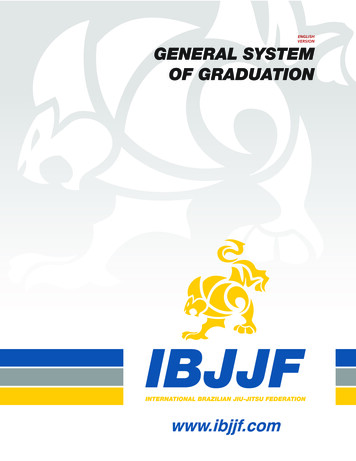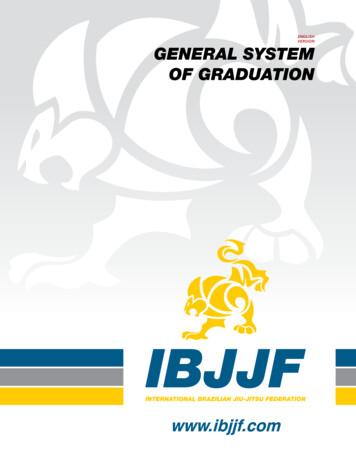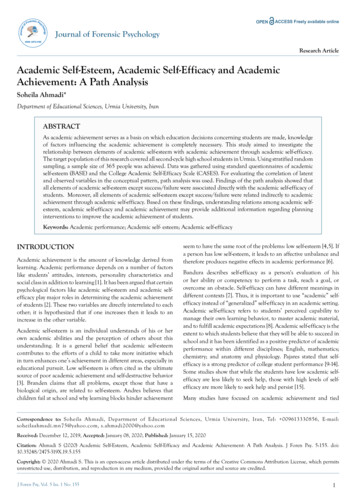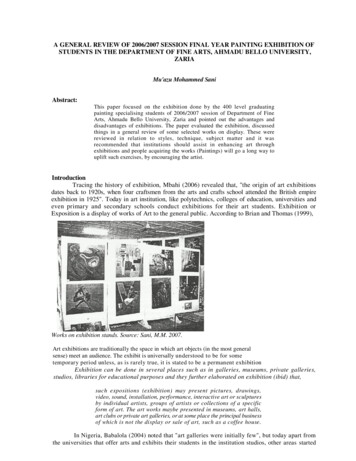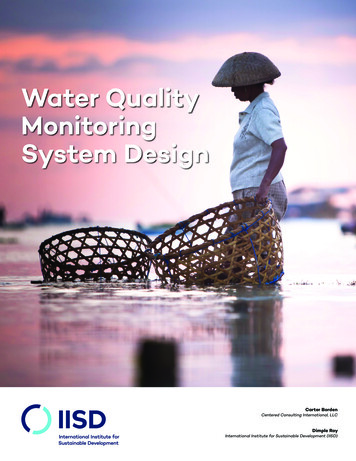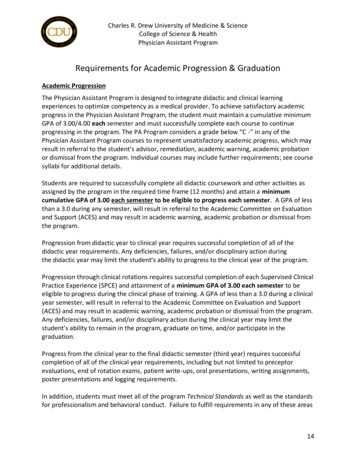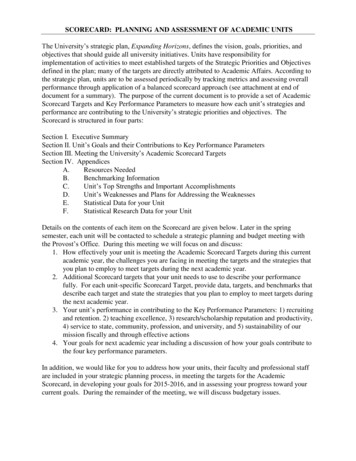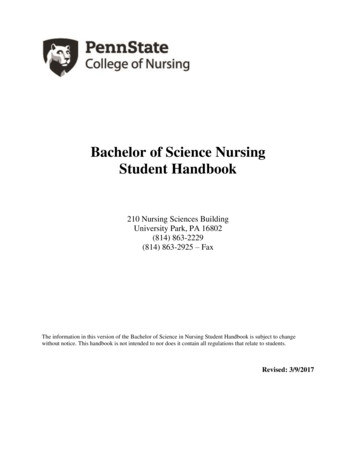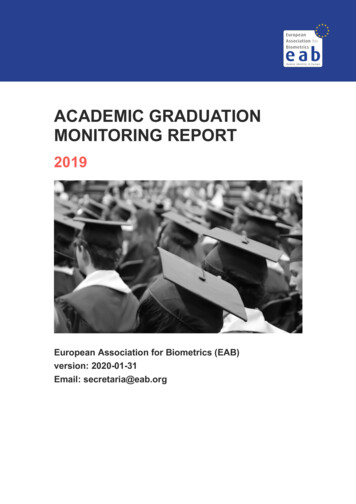
Transcription
ACADEMIC GRADUATIONMONITORING REPORT2019European Association for Biometrics (EAB)version: 2020-01-31Email: secretaria@eab.org
RESEARCHMONITORCONTENTPREFACE . 1MONITOR PHD-THESES . 3Rawabi Alsedais – Shape-Based Person Re-Identification . 4Leatitia Jeancolas – Voice Analysis . 6Klemen Grm – Face Hallucination. 7Gabriel Emile Hine – Anonymous Biometrics. 8Ondřej Kanich - Fingerprint Damage Simulations. 9Chiara Lunerti – Facial Biometrics on Mobile Devices . 10Dominik Malčík – Attacks on Biometric Reference STorage . 11Andreas Nautsch – Speaker Recognition . 12Shi Pan – Presentation Attack Detection . 14Tiago de Freitas Pereira – Face Recognition . 16Patrick Schuch – DL Fingerprint Recognition. 17Ruben Tolosana – Handwriting and Signature Authentication . 18Mateusz Trokielewicz – Iris Recognition . 20Pankaj Wasnik – Biometrics on Smartphones . 21
MONITOR MASTER-THESES. 23NIcole Belvisi – Digital Forensics through Textual Analysis . 24Marta Blazquez – Static Signature Verification . 25Tomáš Coufal – Face Identification . 26Hatim Dali – Video-based Fingerprint Recognition . 27Benjamin Dieckmann – DL-based Pre-Alignment of Fingerprints . 28Florian Domin – Face Morphing Attack Detection . 29Vilém Jelen – Biometric Gateway to Identify People. 30Henrik Kawa – Homomorphic Encryption for Fingerprint Recognition . 31Martin Kubíček – Depth Map from Iris . 32Aleksandar Mitkovski – GAN for Simulating Print-Scan . 33Jan Pawlus – Imitation of Handwriting . 34Alexander Röttcher - Doppelgänger for Face Morphing. 35Claudia Satnoianu – Efects of Beautification on Face Recognition . 36Torsten Schlett – 3D Face Recognition . 37Kacoer Stranski / Lukasz Rybacki – Signature Verification . 38Alexandru Vasile – DL Fingerprint PAD . 39MONITOR BACHELOR-THESES. 40Martin Beneš – Counting People with passive Infrared . 41Angelika Botaljov – Face Recognition under Beautification . 42Clements Brockschmidt – ML based Finger Detection . 43Miguel Caruana – Dynamic Signature Verification . 44David Diaz – Heart Rate Estimation . 45David Dejmal – Fingerprint Quality Assessment . 46Didem Dogan – Face Recognition and Plastic Surgery . 47Vladimír Dušek - Monitoring Pedestrian by Drone . 48Martin Dvořák – Vascular Circulation of Synthetic Retina . 49Marta Fernandez – Face Recognition . 50
Javier Gismero – Dynamic Handwriting Recognition . 51Carlos Gonzalez – Mobile Signature Verification . 52Vladislav Halva – Reconstructing Fingerprint Images . 53Tereza Hytychová – Generating Skin Disease Fingerprint images . 54Dominik Kosík – Gateway to Identify People . 55Vojtěch Kozel – Bloodstream in Retina Images . 56Dominik Križka - Extraction of Face Covered by a Mask . 57Gustavo Manzano – Static Signature Verification . 58Berta Fernandez de la Morena – Bias and Algorithmic Fairness . 59Miguel Lopez – Mobile Handwriting Authentication . 60Bianca Palacková - Retinal Images with Pathological Findings . 61Lukáš Rybnikár – Determine Head Rotation . 62Ivana Stančíková - Disease Impacts to Eye Retina. 63Veronika Svoradová – Synthetic Fingerprint images with Diseases . 64Tereza Sýkorová – Detecting Diabetes From Retina . 65Thao Tran / Nathalie Tkauc – FR and SR for Access Control . 66Nemanja Vasiljević – Partial Fingerprint Detection . 67Žofia Vrábľová – Generating Spoof Effects Fingerprint images . 68Radek Wildmann – Generating Skin Disease Fingerprint images . 69Petr Zubalík – Reconstructing Facial Images. 70
PREFACEDuring the 2019 EAB general assembly in September it was proposed tocompose an annual academic graduation monitoring report, which shouldprovide information about academic theses that are completed in EABmember institutions.Such report should contain lists of entries of Bachelor-, Master- or PhD-thesesand a short summary of each thesis.This report should provide an overview of the research going on in Europe. Ifyou are member of EAB and you can not find any of your 2019 Graduateslisted in this document, then simply send information on the missing thesis to:christoph.busch@ntnu.no.The document will be a living document until the next general assembly inSeptember 2020. Afterwards we will start the monitoring report for the year2020.This report was composed by the European Association for Biometrics (EAB)for its members. If you are not EAB member yet – please join and share thenon-profit spirit of EAB. We are grateful for your continuous support of theEAB initiatives through your membership.
2
MONITORPHD-THESES3
RAWABI ALSEDAIS – SHAPE-BASED PERSON REIDENTIFICATIONFull Title: Shape-Based Person Re-IdentificationInstitution: University of KentSupervisor: Richard GuestContact email: r.m.guest@kent.ac.ukAbstract: The increasing demand for public security, including forensicsecurity, has resulted in a substantial growth in the presence of surveillancecamera networks (i.e., closed-circuit televisions, or CCTVs) in public areas.Significant improvements in the computer vision and machine learning fieldshave advanced the traditional surveillance camera network system (i.e.,monitored by people) towards an intelligent surveillance system involvingautomated person detection, person tracking, activity recognition, and personre-identification. The field of person re-identification has recently receivedmuch attention from computer vision researchers. Appearance model-basedfeatures, which are detection features that are built based on elements of thesubject’s appearance, such as texture, colour, and clothes, are used in personre-identification. However, using the body shape (as one of the appearancemodel-based features) as a signature for person re-identification is an area ofresearch still open for examination.This thesis presents the methodology, implementation, and experimentalframework of a shape-based person re-identification system. The proposedsystem segments the human silhouette into eight different parts: Body, Head& Neck, Shoulders, Middle, Lower, Upper Quarter, Upper Half, Torso, andLower Half. These segmentations are built based on anthropometry studies.This system exploits the shape descriptor information of these segments tobuild a subject-unique signature for person re-identification using a GenericFourier Descriptor (GFD). The discrimination level of shape-based signaturesare assessed by classifying them using image-based and video-basedapproaches. The image-based system classifies the signatures on a frameby-frame basis using Linear Discriminant Analysis (LDA), which evaluates thefeasibility of re-identifying subjects based on their shape static feature. Thevideo-based approach exploits the signatures of the entire sequence (i.e.,multiple frames) to re-identify subjects based on their dynamic features thatoccur within a collection of frames using Dynamic Time Warping (DTW).Comprehensive system outcomes for image-based and video-based systemsare analysed by comparing the performance of both systems for eachsegment individually. Finally, a rank list fusion method, which combines theimage-based generated rank lists so that the lists generated by all frames ineach sequence are replaced by one rank list for the entire sequence, isproposed for performance enhancement. Extensive experiments wereconducted using publicly available dataset to evaluate the proposed shapebased person re-identification. In scenarios where a subject who maintainsthe same appearance is identified and re-identified from the same angle, theimage-based and video-based approaches were found to outperform anumber of state-of-art systems. In situations where the subject is identifiedand re-identified from different viewing angles (inter-view) and with a changein appearance (cross-scenario), the results reflected a comparable4
performance. The results of the rank list fusion implementation indicatesuperior performance enhancement in all situations, including the inter-viewand cross-scenario.5
LEATITIA JEANCOLAS – VOICE ANALYSISFull Title: Detection of the Parkinson disease in early stages through voiceanalysisInstitution: Institut Mines Telecom-Telecom SudParis-IPPSupervisor: Dijana Petrovska / Badr-Eddine Benkelfat / Habib BenaliContact email: leatitia.jeancolas@telecom-sudparis.euAbstract: Vocal impairments, known as hypokinetic dysarthria, are one of thefirst symptoms to appear in Parkinson's Disease (PD). A large number ofarticles exist on PD detection through voice analysis, but few have focused onthe early stages of the disease. Furthermore, to our knowledge, study hadbeen published on remote PD detection via speech transmitted through thetelephone channel. The aim of this PhD work was to study vocal changes inPD at early and preclinical stages, and develop automatic detection andmonitoring models. The long-term purpose is to build a cheap early diagnosisand monitoring tool, that doctors could use at their office, and even moreinterestingly, that could be used remotely with any telephone.The first step was to build a large voice database with more than 200 Frenchspeakers, including early PD patients, healthy controls and idiopathic Rapideye movement sleep Behavior Disorder (iRBD) subjects, who can beconsidered at PD preclinical stage. All these subjects performed differentvocal tasks and were recorded with a professional microphone, with theinternal microphone of a computer. Moreover, they called one a month aninteractive voice server, with their own phone. We studied the effect ofmicrophone quality, speech tasks, gender, and classification analysismethodologies.We analyzed the vocal recordings with three different analysis methods,covering different time scale analyses. We started with cepstral coefficientsand Gaussian Mixture Models (GMM), then we adapted x-vectorsmethodology (which never had been used in PD detection) and finally weextracted global features classified with Support Vector Machine (SVM). Wedetected vocal impairments at PD early and preclinical stages in articulation,prosody, speech flow and rhythmic abilities.With the professional microphone recordings, we obtained an accuracy (Acc)of 89% for male early PD detection, just using 6min of reading, free speech,fast and slow syllable repetitions. As for women, we reached Acc 70% with1min of free speech. With the telephone recordings, we achieved Acc 75%for men, with 5min of rapid syllable repetitions, and 67% for women, with 5minof free speech. These results are an important first step towards early PDtelediagnosis.We also studied correlations with neuroimaging, and we were able to linearlypredict DatScan and Magnetic Resonance Imaging (MRI) neuromelaninsensitive data, from a set of vocal features, in a significant way. This latterresult is promising regarding the possible future use of voice for early PDmonitoring.6
KLEMEN GRM – FACE HALLUCINATIONFull Title: Face hallucination using cascaded super-resolution and identitypriorsInstitution: University of LjubljanaSupervisor: Vitomir StrucContact email: klemen.grm@fe.uni-lj.siAbstract: In this thesis we address the problem of hallucinating highresolution facial images from low-resolution inputs at high magnificationfactors. We approach this task with convolutional neural networks (CNNs) andpropose a novel face hallucination model that incorporates identity priors intothe learning procedure. The model consists of two main parts: i) a cascadedsuper-resolution network that upscales the low-resolution facial images, andii) an ensemble of face recognition models that act as identity priors for thesuper-resolution network during training. Different from most competingsuper-resolution techniques that rely on a single model for upscaling (evenwith large magnification factors), our network uses a cascade of multiple SRmodels that progressively upscale the low-resolution images using steps of2 . This characteristic allows us to apply supervision signals (targetappearances) at different resolutions and incorporate identity constraints atmultiple-scales. The proposed C-SRIP model (Cascaded Super Resolutionwith Identity Priors) is able to upscale low-resolution images and produceconvincing results for diverse inputs. We evaluate our model on severaldatasets and report superior performance compared to the state-of-the-art.7
GABRIEL EMILE HINE – ANONYMOUS BIOMETRICSFull Title: Aymous BiometricsInstitution: Roma Tre UniversitySupervisor: Patrizio CampisiContact email: gabriel.hine@uniroma3.itAbstract: In this thesis, I developed techniques that enable to use ofbiometric traits for authentication in an anonymous manner.At first glance, the concept of anonymous biometrics seems quite odd sincebiometric traits are closely linked to our identity. Moreover, the widespreadadoption of biometrics in forensics, border control, surveillance applicationshas biased the general vision that users have if asked to show theirbiometrics.The basic idea behind anonymous biometrics is to do not use biometricsthemselves as identifiers, but rather bind the biometric trait with a secret keythat acts as the authenticator. The biometric trait becomes a factor of theauthentication protocol that lets the user reproduce the identifier that has beenpreviously assigned to him. In this way, the authentication service providerdoes not need to know the biometric sample itself, or any representation ofit. Because of the intrinsic noisiness of biometrics, classical cryptographictechniques are not suitable, and specific techniques, known as biometriccryptosystems, have been developed.In this context, I present a novel biometric cryptosystem obtaining perfectsecurity, that is not leaking any information about the employed secret keyfrom the knowledge of the data stored in the database. While similar methodshave already been sought in the literature, the approaches proposed so farhave been evaluated in terms of recognition performance under the unrealisticassumption of ideal statistical distributions for the considered biometric data.Conversely, in this thesis, I investigate the applicability of the proposedframework to practical scenarios while managing a trade-off between privacyand recognition performance. This goal has been achieved by introducing aclass of transformation functions enforcing zero-leakage secrecy, bydesigning an adaptive strategy for embedding the secret key bits into theselected features, and by developing a system parameters optimizationstrategy with respect to security, recognition performance, and privacy.Experimental tests conducted on real fingerprint data prove the effectivenessof the proposed scheme.Another important aspect is to ensure untraceability along with differentservices. That means that we should be able to produce different identifiersstarting from the same biometric trait, but these should be indistinguishablefrom identifiers originated by independent users.The vulnerability of our system to the linkability attack has been analysed andan enhanced system is proposed in order to counteract it.A frequently neglected aspect in cryptosystem design proposals and analysisis the impossibility to synchronise signals once they are encrypted. Any kindof biometric should be aligned before doing any comparison. That means thatfurther auxiliary data must be stored as a reference. This could leak too muchinformation making the cryptosystem design useless. In this context, Ipropose a novel translation-invariant representation for fingerprint minutiae.8
ONDŘEJ KANICH - FINGERPRINT DAMAGE SIMULATIONSFull Title: Research in Fingerprint Damage SimulationsInstitution: Brno University of TechnologySupervisor: Martin DrahanskýURL: tact email: drahan@fit.vutbr.czAbstract: The goal of this research is to develop methods for fingerprintdamage simulations. In the first part of this thesis the emphasis is placed on asummary of the current knowledge of synthetic fingerprint generation and thedamage to these fingerprints. Moreover, general information aboutfingerprints, fingerprint recognition, and phenomena that damage fingerprintsincluding skin diseases are stated herein. This thesis contains the design andimplementation of the SyFDaS application for generation and modulardamaging of fingerprints. The next part is a description of methods fordamage by swipe mode, narrow sensor, damaged sensor, pressure andmoisture, skin distortion, warts, atopic eczema, and psoriasis. Several othertypes of damage, including fingerprint spoofs, are analyzed. Overall, there are43 basic damages which were visually verified. Due to damage combinations,there are 1,171 types of damage and 348,300 fingerprint images generated,which were evaluated by four different quality measurement methods.9
CHIARA LUNERTI – FACIAL BIOMETRICS ON MOBILEDEVICESFull Title: Facial Biometrics on Mobile Devices: Interaction and QualityAssessmentInstitution: University of KentSupervisor: Richard GuestContact email: r.m.guest@kent.ac.ukAbstract: Biometric face recognition is a quick and convenient securitymethod that allows unlocking a smartphone device without the need toremember a PIN code or a password. However, the unconstrained mobileenvironment brings considerable challenges in facial verification performance.Not only the verification but also the enrolment on the mobile device takesplace in unpredictable surroundings. In particular, facial verification involvesthe enrolment of unsupervised users across a range of environmentalconditions, light exposure, and additional variations in terms of user’s posesand image background. Is there a way to estimate the variations that a mobilescenario introduces over the facial verification performance? A qualityassessment can help in enhancing the biometric performance, but in thecontext of mobile devices, most of the standardised requirements andmethodology presented are based on passport scenarios. A comprehensiveanalysis should be performed to assess the biometric performance in terms ofimage quality and user interaction in the particular context of mobile devices.This work aimed to contribute to improving the performance and theadaptability of facial verification systems implemented on smartphones. Fiftythree participants were asked to provide facial images suitable for faceverification across several locations and scenarios. A minimum of 150 imagesper user was collected with a smartphone camera within three differentsessions. Sensing data was recorded to assess user interaction during thebiometric presentation. Images were also recorded using a Single Lens Reflexcamera to enable a comparison with conditions similar to a passport scenario.Results showed the relationship within five selected quality metrics commonlyused for quality assessment and the variables introduced by the environment,the user and the camera. Innovative methodologies were also proposed toassess the user interaction using sensors implemented in the smartphone.The analysis underlined important issues and formulated useful observationsto enhance facial verification performance on smartphone devices.10
DOMINIK MALČÍK – ATTACKS ON BIOMETRIC REFERENCESTORAGEFull Title: Analysis of attacks on (micro)chips and development ofenhancement of their robustness/securityInstitution: Brno University of TechnologySupervisor: Martin DrahanskýURL: tact email: drahan@fit.vutbr.czAbstract: Nowadays, microchips are used virtually everywhere, from simplehome devices to confidential military equipment. In many scenarios, sensitivedata is being processed by these devices. For example, in the case ofelectronic personal documents, fingerprints, facial images, and personal dataare processed by the chip; and in some cases also iris images. Auditingproclaimed functions and a level of security of such microchips is becoming avalued service. In this doctoral thesis, we present an experimentally provenprocess for the microscopic analysis of chips, feasible in a low-cost setup.The described process was demonstrated on a chip acquired from the Czechbiometric passport - from extracting the chip out of the plastic card up toanalysis of the acquired microscopic images. We investigated and evaluatedvarious potentially viable methods for logic element recognition; without theemployment of machine-learning. Additionally, hardware-oriented attacks arediscussed and followed by proposals for countermeasures leading to thehindering of microscopic analysis.11
ANDREAS NAUTSCH – SPEAKER RECOGNITIONFull Title: Speaker Recognition in Unconstrained EnvironmentsInstitution: Hochschule DarmstadtSupervisor: Christoph BuschURL: rtation-anautschFassung-20191028.pdfContact email: nautsch@eurecom.frAbstract: Speaker recognition is applied in smart home devices, interactivevoice response systems, call centers, online banking and payment solutionsas well as in forensic scenarios. This dissertation is concerned with speakerrecognition systems in unconstrained environments. Before this dissertation,research on making better decisions in unconstrained environments wasinsufficient. Aside from decision making, unconstrained environments implytwo other subjects: security and privacy. Within the scope of this dissertation,these research subjects are regarded as both security against short-termreplay attacks and privacy preservation within state-of-the-art biometric voicecomparators in the light of a potential leak of biometric data. The aforementioned research subjects are united in this dissertation to sustain gooddecision making processes facing uncertainty from varying signal quality andto strengthen security as well as preserve privacy.Conventionally, biometric comparators are trained to classify between matedand non-mated reference – probe pairs under idealistic conditions but areexpected to operate well in the real world. However, the more the voice signalquality degrades, the more erroneous decisions are made. The severity oftheir impact depends on the requirements of a biometric application. In thisdissertation, quality estimates are proposed and employed for the purpose ofmaking better decisions on average in a formalized way (quantitative method),while the specifications of decision requirements of a biometric applicationremain unknown. By using the Bayesian decision framework, the specificationof application-depending decision requirements is formalized, outliningoperating points: the decision thresholds. The assessed quality conditionscombine ambient and biometric noise, both of which occurring in commercialas well as in forensic application scenarios. Dual-use (civil and governmental)technology is investigated. As it seems unfeasible to train systems for everypossible signal degradation, a low amount of quality conditions is used. Afterexamining the impact of degrading signal quality on biometric featureextraction, the extraction is assumed ideal in order to conduct a fairbenchmark. This dissertation proposes and investigates methods forpropagating information about quality to decision making. By employingquality estimates, a biometric system’s output (comparison scores) isnormalized in order to ensure that each score encodes the least-favorabledecision trade-off in its value. Application development is segregated fromrequirement specification. Furthermore, class discrimination and scorecalibration performance is improved over all decision requirements for realworld applications.In contrast to the ISO/IEC 19795-1:2006 standard on biometric performance(error rates), this dissertation is based on biometric inference for probabilisticdecision making (subject to prior probabilities and cost terms). Thisdissertation elaborates on the paradigm shift from requirements by error rates12
to requirements by beliefs in priors and costs. Binary decision error trade-offplots are proposed, interrelating error rates with prior and cost beliefs, i.e.,formalized decision requirements. Verbal tags are introduced to summarizecategories of least-favorable decisions: the plot’s canvas follows fromBayesian decision theory. Empirical error rates are plotted, encodingcategories of decision trade-offs by line styles. Performance is visualized inthe latent decision subspace for evaluating empirical performance regard- ingchanges in prior and cost based decision requirements.Security against short-term audio replay attacks (a collage of sound unitssuch as phonemes and syllables) is strengthened. The unit-selection attack isposed by the ASVspoof 2015 challenge (English speech data), representingthe most difficult to detect voice presentation at- tack of this challenge. In thisdissertation, unit-selection attacks are created for German speech data,where support vector machine and Gaussian mixture model classifiers aretrained to detect collage edges in speech representations based on waveletand Fourier analyses. Competitive results are reached compared to thechallenged submissions.Homomorphic encryption is proposed to preserve the privacy of biometricinformation in the case of database leakage. In this dissertation, log-likelihoodratio scores, representing biometric evidence objectively, are computed in thelatent biometric subspace. Conventional comparators rely on the featureextraction to ideally represent biometric information, latent subspacecomparators are trained to find ideal representations of the biometricinformation in voice reference and probe samples to be compared. Twoprotocols are proposed for the the two-covariance comparison model, aspecial case of probabilistic linear discriminant analysis. Log-likelihood ratioscores are computed in the encrypted domain based on encryptedrepresentations of the biometric reference and probe. As a consequence, thebiometric information conveyed in voice samples is, in contrast to manyexisting protection schemes, stored protected and without information loss.The first protocol preserves privacy of end-users, requiring one public/privatekey pair per biometric application. The latter protocol preserves privacy ofend-users and comparator vendors with two key pairs. Comparators estimatethe biometric evidence in the latent subspace, such that the subspace modelrequires data protection as well. In both protocols, log-likelihood ratio baseddecision making meets the requirements of the ISO/IEC 24745:2011 biometricinformation protection standard in terms of unlinkability, irreversibility, andrenewability properties of the protected voice data.13
SHI PAN – PRESENTATION ATTACK DETECTIONFull Title: Conventional and Neural Architectures for Biometric PresentationAttack DetectionInstitution: University of KentSupervisor: Farzin DeraviContact email: sp641@kent.ac.uk, f.deravi@kent.ac.ukAbstract: Facial biometrics, which enable an efficient and reliable method ofperson recognition, have been growing continuously as an active sub-area ofcomputer vision. Automatic face recognition offers a natural and non-intrusivemethod for recognising users from their facial characteristics. However, facialrecognition systems are vulnerable to presentation attacks (or spoofingattacks) when an attacker attempts to hide their true identity andmasquerades as a valid user by misleading the biometric system. Thus,Facial Presentation Attack Detection (Facial PAD) (or facial anti-spoofing)techniques that aim to protect face recognition systems from such attacks,have been attracting more research attention in recent years. Varioussystems and algorithms have been proposed and evaluated. This thesisexplores and compares some novel directions for detecting facial presentationattacks, including traditional features as well as approaches based on deeplearning. In particular, different features encapsulating temporal informationare developed and explored for describing the dynamic characteristics inpresentation attacks. Hand-crafted features, deep neural architectures andtheir possible extensions are explored for their application in PAD.The proposed novel traditional features address the problem of modellingdistinct representations of presentation attac
During the 2019 EAB general assembly in September it was proposed to compose an annual academic graduation monitoring report, which should . The image-based system classifies the signatures on a frame-by-frame basis using Linear Discriminant Analysis (LDA), which evaluates the . number of state-of-art systems. In situations where the .


